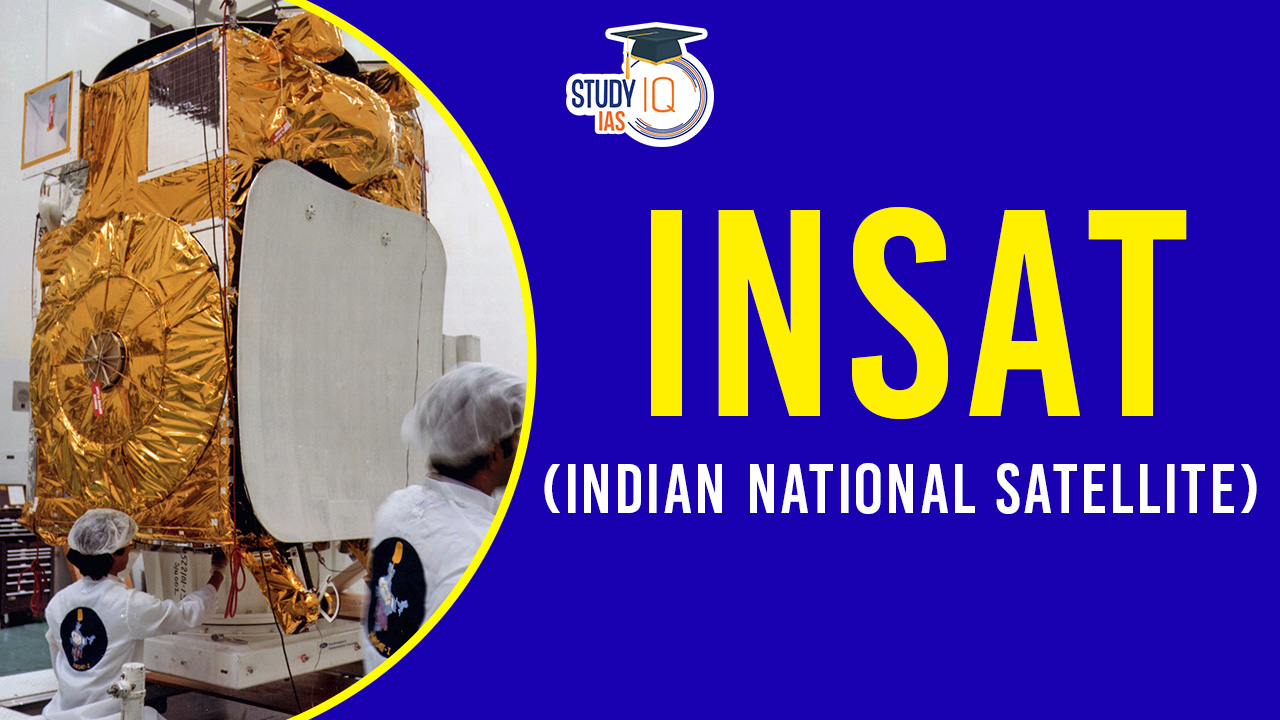Table of Contents
INSAT (Indian National Satellite) system is a series of geostationary satellites operated by the Indian Space Research Organisation (ISRO). These satellites are primarily used for telecommunications, broadcasting, meteorology, and search and rescue operations. The INSAT system has played a significant role in improving communication and weather forecasting in India and the surrounding regions.
INSAT (Indian National Satellite)
INSAT (Indian National Satellite) is a geostationary satellite program by ISRO, serving telecommunications, broadcasting, meteorology, and search and rescue operations since 1983. It is a collaborative effort involving multiple Indian government departments and agencies. INSAT satellites provide communication and meteorological capabilities, including distress alert signal reception for search and rescue missions in the South Asian and Indian Ocean Region. ISRO’s participation in the Cospas-Sarsat program strengthens its commitment to these critical functions.
We’re now on WhatsApp. Click to Join
Indian National Satellite System (INSAT)
The INSAT system, initiated with the launch of INSAT-1B in August 1983 (following the earlier unsuccessful INSAT-1A launch in April 1982), has been a transformative force in India. It revolutionized television and radio broadcasting, telecommunications, and meteorology. This system facilitated the rapid extension of TV and modern telecom services to remote regions and offshore islands. INSAT offers transponders in C, Extended C, and Ku bands for various communication services. Some INSAT satellites also carry meteorological instruments and data relay capabilities for meteorological services. KALPANA-1, in particular, is a dedicated meteorological satellite. The vital task of monitoring and controlling these satellites falls under the purview of Master Control Facilities located in Hassan and Bhopal.
INSAT (Indian National Satellite) History
| Year | Event |
| 1982 | INSAT-1A, the first satellite, launched (failed) |
| 1983 | INSAT-1B launched, marking the system’s beginning |
| 1988 | Launch of INSAT-1C (partial failure in orbit) |
| 1990 | INSAT-1D launched, further expanding the system |
| 1992 | Introduction of INSAT-2A, enhancing capabilities |
| 1993 | INSAT-2B launched, continuing system development |
| 1995 | INSAT-2C added to the fleet |
| 1997 | Launch of INSAT-2D (failed in orbit) |
| 1999 | INSAT-2E introduced, strengthening the system |
| 2002 | KALPANA-1, a dedicated meteorological satellite, launched |
| 2003 | INSAT-3A added to the constellation |
| 2007 | Introduction of INSAT-4B, enhancing broadcasting services |
| 2010 | Launch of GSAT-4 and GSAT-5P (both unsuccessful) |
| 2011 | GSAT-8 and GSAT-12 launched, expanding capacity |
| 2012-2019 | Introduction of GSAT series satellites, increasing capabilities |
| 2018-2020 | Launch of GSAT-29, GSAT-11, GSAT-7A, and more, enhancing communication services |
| 2020-2022 | CMS-01 and CMS-02 satellites launched, serving communication and meteorological purposes |
List of INSAT (Indian National Satellite)
| Serial No. | Satellite | Date of Launch | Launch Vehicle | Status |
| 1 | INSAT-1A | 10 April 1982 | Delta | Failed in orbit |
| 2 | INSAT-1B | 30 August 1983 | Shuttle PAM-D | Mission Completed |
| 3 | INSAT-1C | 22 July 1988 | Ariane-3 | Partial failure in orbit |
| 4 | INSAT-1D | 12 June 1990 | Delta | Mission Completed |
| 5 | INSAT-2A | 10 July 1992 | Ariane-4 | Mission Completed |
| 6 | INSAT-2B | 23 July 1993 | Ariane-4 | Mission Completed |
| 7 | INSAT-2C | 7 December 1995 | Ariane-4 | Mission Completed |
| 8 | INSAT-2D | 4 June 1997 | Ariane-4 | Failed in Orbit |
| 9 | INSAT-2E | 3 April 1999 | Ariane-4 | Mission Completed |
| 10 | INSAT-3B | 22 March 2020 | Ariane-5 | Mission Completed |
| 11 | GSAT-1 | 18 April 2001 | GSLV | Mission Completed |
| 12 | INSAT-3C | 24 January 2002 | Ariane-5 | Mission Completed |
| 13 | KALPANA-1 | 12 September 2002 | PSLV | Mission Completed |
| 14 | INSAT-3A | 10 April 2003 | Ariane-5 | Mission Completed |
| 15 | GSAT-2 | 8 May 2003 | GSLV | |
| 16 | INSAT-3E | 28 September 2003 | Ariane-5 | |
| 17 | EDUSAT | 20 September 2004 | GSLV | Mission Completed |
| 18 | HAMSAT | 5 May 2005 | PSLV | |
| 19 | INSAT-4A | 22 December 2005 | Ariane-5 | |
| 20 | INSAT-4C | 10 July 2006 | GSLV | Launch unsuccessful |
| 21 | INSAT-4B | 12 March 2007 | Ariane-5 | Mission Completed |
| 22 | INSAT-4CR | 2 September 2007 | GSLV | |
| 23 | GSAT-4 | 15 April 2010 | GSLV | Launch unsuccessful |
| 24 | GSAT-5P | 25 December 2010 | GSLV-F06 | Launch unsuccessful |
| 25 | GSAT-8 | 21 May 2011 | Ariane-5 | |
| 26 | GSAT-12 | 15 July 2011 | PSLV-C17 | |
| 27 | GSAT-10 | 29 September 2012 | Ariane-5 | |
| 28 | GSAT-7 | 30 August 2013 | Ariane-5 | |
| 29 | GSAT-14 | 5 January 2014 | GSLV-D5 | |
| 30 | GSAT-16 | 7 December 2014 | Ariane-5 | |
| 31 | GSAT-6 | 27 August 2015 | GSLV-D6 | |
| 32 | GSAT-15 | 11 November 2015 | Ariane-5 | |
| 33 | GSAT-18 | 6 October 2016 | Ariane-5 | |
| 34 | GSAT-9 | 5 May 2017 | GSLV-F09 | |
| 35 | GSAT-19 | 5 June 2017 | GSLV MkIII – D1 | |
| 36 | GSAT-17 | 29 June 2017 | Ariane-5 | |
| 37 | GSAT-6A | 29 March 2018 | GSLV-F08 | Failed in Orbit |
| 38 | GSAT-29 | 14 November 2018 | GSLV MkIII-D2 | |
| 39 | GSAT-11 | 5 December 2018 | Ariane-5 | |
| 40 | GSAT-7A | 19 December 2018 | GSLV-F11 | |
| 41 | GSAT-31 | 6 February 2019 | Ariane-5 VA-247 | |
| 42 | GSAT-30 | 17 January 2020 | Ariane-5 VA-251 | |
| 43 | CMS-01 | 17 December 2020 | PSLV-C50 | |
| 44 | CMS-02 | 23 June 2022 | Ariane-5 VA-257 |
Applications of INSAT (Indian National Satellite)
The Indian National Satellite (INSAT) system serves a wide range of applications, and here are some examples of how these applications are put to use:
Telecommunications
Telephone and Internet Services: INSAT facilitates long-distance and rural telecommunications. For example, it supports the expansion of telephone and internet services to remote villages in India, connecting people who were previously isolated.
Television Broadcasting
Direct-to-Home (DTH) Services: INSAT enables DTH broadcasting services like Tata Sky and Dish TV, which deliver a wide array of television channels directly to viewers’ homes.
Meteorology and Weather Forecasting
Cyclone Tracking: INSAT satellites track the movement of cyclones. For instance, they provide critical information to the India Meteorological Department (IMD) to issue warnings and plan evacuation measures, as demonstrated during Cyclone Amphan in 2020.
Search and Rescue Operations
Distress Signal Reception: INSAT satellites help locate distressed vessels and individuals. For example, when a boat or aircraft sends a distress signal, INSAT assists in pinpointing their location, aiding in timely rescue operations.
Earth Observation
Agricultural Monitoring: INSAT data is used to monitor crops and assess their health. It assists farmers in optimizing irrigation, fertilizer use, and crop planning.
Urban Planning: INSAT images are valuable for city planning, infrastructure development, and monitoring urban growth.
Disaster Management
Flood Monitoring: INSAT helps monitor rainfall patterns and river water levels, aiding in flood prediction and response. For instance, it was instrumental during the 2019 Kerala floods.
Drought Assessment: INSAT data is used to assess drought conditions, allowing for targeted relief efforts during water shortages.
Navigation
Augmentation of Navigation Systems: While not a primary navigation system, INSAT can provide augmentation to satellite-based navigation systems. It offers location and timing information to enhance navigation accuracy in applications such as civil aviation and maritime navigation.
Education and Research
E-Learning: INSAT is used for educational purposes, including e-learning programs. It helps deliver educational content to remote areas with limited access to traditional schools.
Scientific Research: Researchers use INSAT data for various scientific studies, such as monitoring environmental changes and conducting atmospheric research.
Data Relay
Remote Sensing Data Transmission: INSAT is used to relay data from remote environmental monitoring stations. For instance, it aids in the transmission of data from weather stations in remote mountainous regions.
Rural Development
E-Governance: INSAT supports e-governance initiatives in rural areas by enabling connectivity for government services, such as digital land records and birth certificates.
Future Developments For INSAT System
- The introduction of the new L1 band is set to facilitate the widespread adoption of NavIC technology in wearable smart devices and IoT (Internet of Things) devices.
- In 2023, the NVS-01 satellite is scheduled for launch aboard a GSLV (Geosynchronous Satellite Launch Vehicle). NVS-01 will serve as a replacement for the IRNSS-1G satellite.
- The Aditya-L1 Mission represents a significant milestone in solar research, as it will provide an unprecedented level of detail in the study of the Sun.
- The Indian Space Research Organization (ISRO) is actively engaged in the development of a third iteration of the GSLV (Geosynchronous Satellite Launch Vehicle). This development signifies the continuous improvement and evolution of India’s launch vehicle capabilities.
Benefits of INSAT (Indian National Satellite)
The Indian National Satellite (INSAT) system has brought about a multitude of benefits for India and its neighboring countries, playing a pivotal role in various aspects of life and infrastructure development.
- Telecommunications and Broadcasting: INSAT has significantly improved telecommunications by providing voice, data, and video communication services, expanding connectivity even to remote regions. It has revolutionized television broadcasting, making a wide range of channels accessible through direct-to-home (DTH) services.
- Meteorology and Disaster Management: INSAT satellites provide real-time weather data, aiding in weather forecasting, cyclone tracking, and early warning systems. This has proven invaluable in disaster management, mitigating the impact of natural calamities.
- Search and Rescue Operations: The system’s distress signal reception capability helps locate and assist distressed individuals and vessels in the South Asian and Indian Ocean regions.
- Agriculture and Food Security: INSAT data supports crop monitoring, facilitating optimal agricultural practices, improved yields, and food security.
- Rural Development and Education: INSAT bridges the digital divide by providing connectivity to remote areas, promoting e-governance, and facilitating e-learning initiatives.
- National Security: It plays a role in secure government and defense communication.
- Space Technology Advancement: The development of the INSAT system has bolstered India’s capabilities in space technology.
- International Cooperation: INSAT supports international disaster warning and relief efforts in the Indian Ocean region.
Indian National Satellite System (INSAT) UPSC
The Indian National Satellite (INSAT) system, initiated in 1983 by ISRO, has transformed India’s telecommunications, broadcasting, meteorology, and disaster response. It provides vital services such as long-distance communications, television broadcasting, cyclone tracking, and distress signal reception. INSAT aids in agriculture, urban planning, disaster management, navigation augmentation, and remote data relay. Its impact extends to education, scientific research, rural development, and national security. Future developments include NavIC technology integration, the launch of NVS-01 in 2023, the Aditya-L1 solar research mission, and the evolution of the GSLV. INSAT’s contributions have significantly improved the quality of life and infrastructure in India and neighboring regions.


 SIPRI Report on Global Arms Spending and...
SIPRI Report on Global Arms Spending and...
 Lipids, Types, Structure and Examples
Lipids, Types, Structure and Examples
 RNA-Based Antiviral for Deadly Agricultu...
RNA-Based Antiviral for Deadly Agricultu...





















